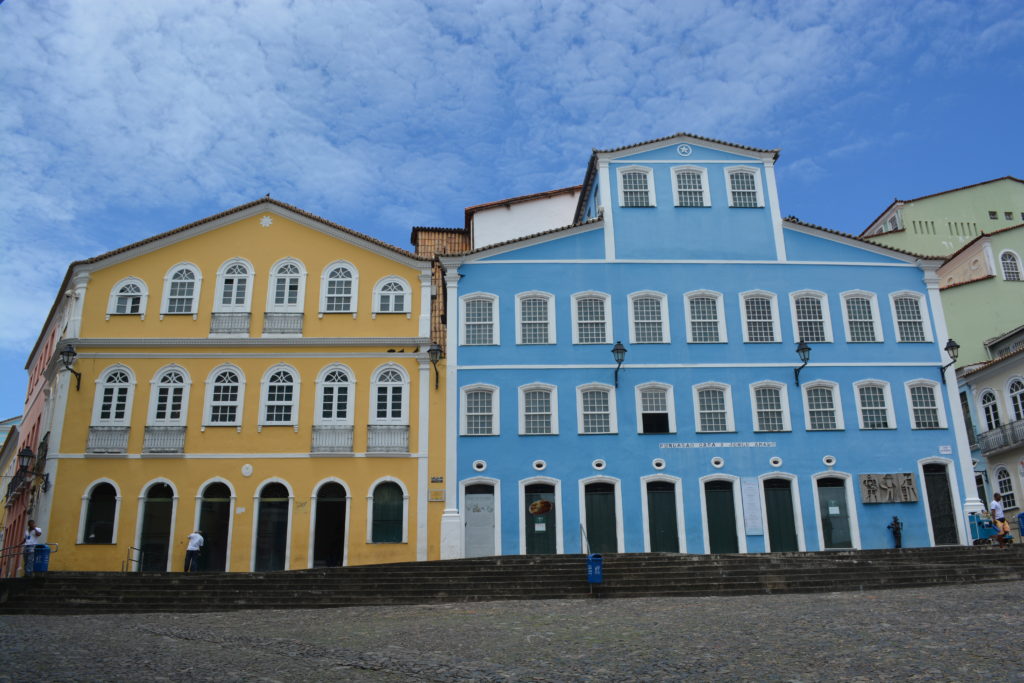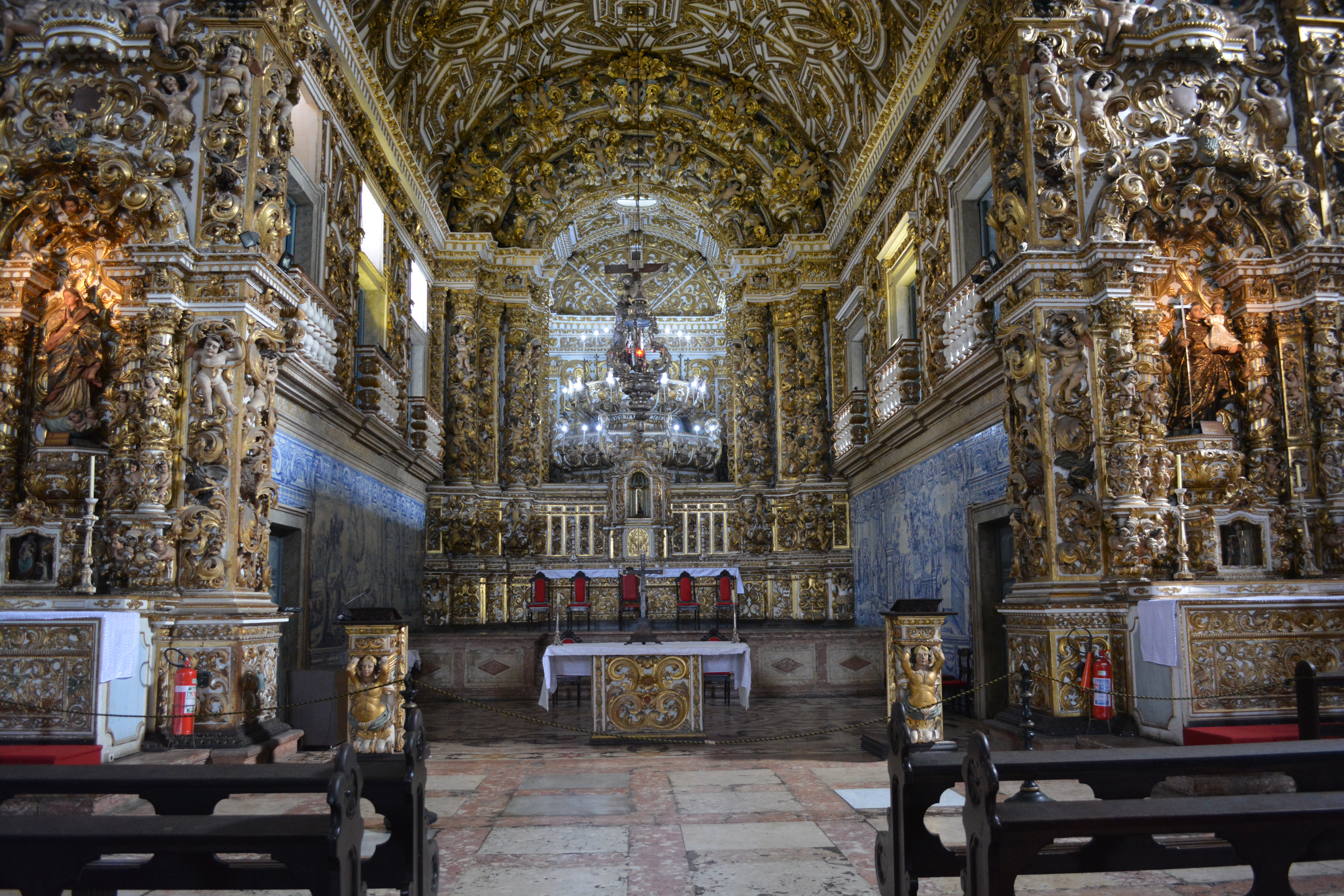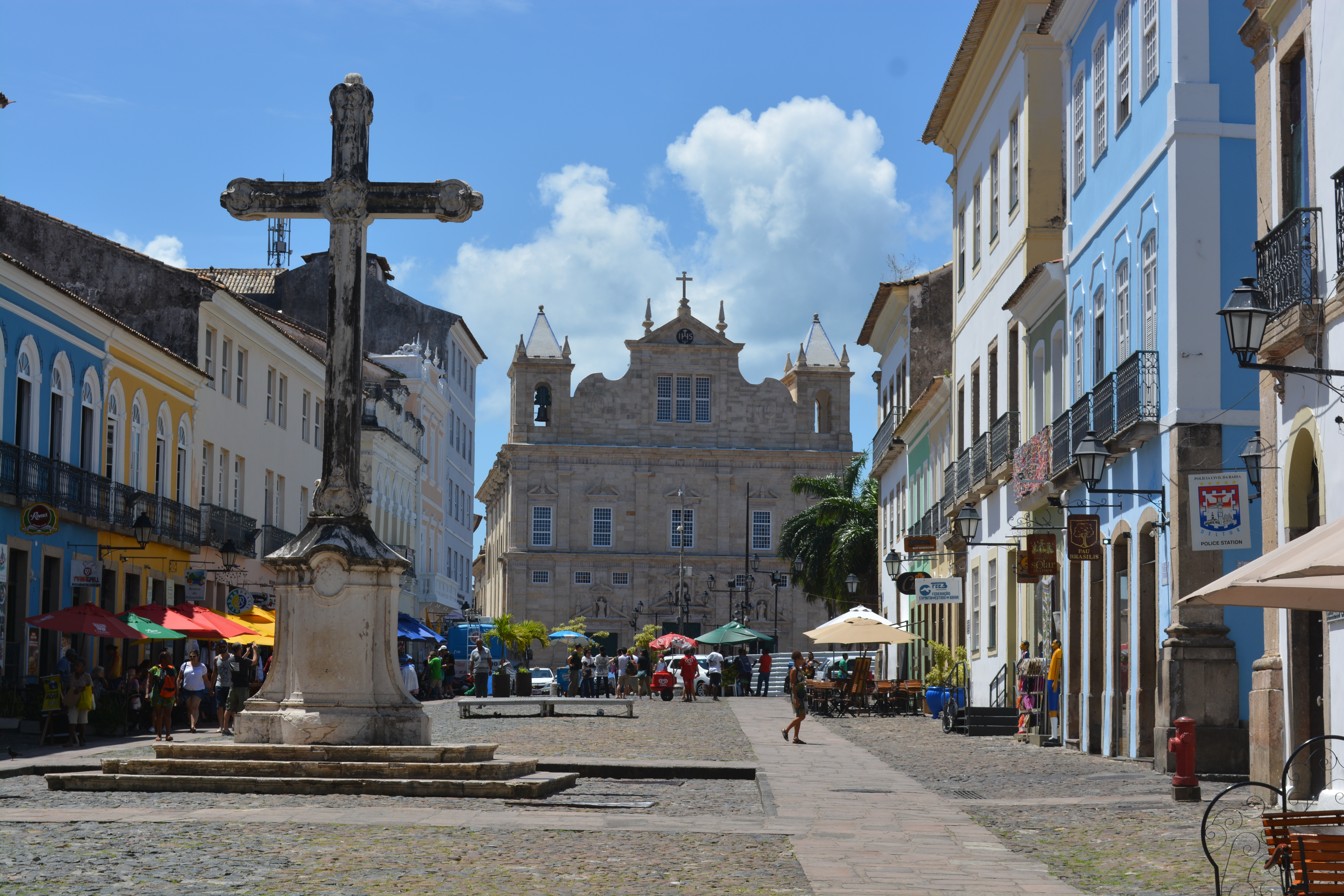Salvador, the capital of Bahia, is a vibrant city renowned for its rich cultural heritage, diverse population, and significant historical role in Brazil. Designated a UNESCO World Heritage Site in 1985, the city’s colonial architecture and Afro-Brazilian culture make it a unique destination. With a population of approximately 2.9 million, Salvador is one of Brazil’s largest cities, showcasing a blend of modern life and historical tradition.
On the Journey to Salvador
From Olinda on our Dragoman truck we drove down the coast to Salvador. After 527kms we made an overnight stop in Aracaju, the capital of Sergipe, known for its beautiful beaches and relaxed atmosphere. The next day we drove the 333kms from Aracaju to Salvador stopping off for lunch Project Tamar in Praia de Forte showcased efforts to protect marine turtles and offered insights into Brazil’s rich marine biodiversity. In Salvador we stayed at Pousada Mangueira close to the centre and great views across to the centre of the city. Salvador marked the terminus of this leg of the Dragoman journey and where a number of travellers ended their trip, and some new ones joined. Our Dragoman journey was to carry on to the end at Rio de Janeiro.
Geography & Climate
Situated on the northeastern coast of Brazil, Salvador is positioned on a beautiful peninsula that divides the All Saints Bay from the Atlantic Ocean. The city enjoys a tropical climate, characterised by warm temperatures year-round, with average highs around 28°C (82°F) and distinct wet and dry seasons. Rainfall peaks between April and July, but the coastal location means that pleasant sea breezes help moderate the heat.
History & Economy
Founded in 1549 by Tomé de Souza, Salvador was Brazil’s first capital until 1763. Its location made it a pivotal port for the transatlantic slave trade, which has significantly influenced the city’s demographics and culture. Today, Salvador serves as a major economic hub in Brazil, primarily driven by tourism, commerce, and the service sector. The historical significance and vibrant culture attract millions of visitors each year.

Key Sites
Pelourinho
The historic centre of Salvador, Pelourinho, is a UNESCO World Heritage Site celebrated for its cobbled streets, colourful colonial buildings, and lively atmosphere. It is a cultural epicentre, hosting numerous festivals, street performances, and cultural events throughout the year.

Catedral Basílica de Salvador
This stunning baroque cathedral, built between 1657 and 1672, features intricate gold leaf interiors and impressive altarpieces. The opulent decorations and historical significance of the cathedral make it a key landmark in Salvador, where visitors can admire the craftsmanship that reflects the wealth of the colonial era.
Igreja de São Francisco
Arguably one of the most significant churches in Brazil, the Igreja de São Francisco, constructed between 1708 and 1750, is renowned for its spectacular interior adorned with gold leaf and intricate wood carvings. This church showcases an opulence that is almost overwhelming. The altarpieces, covered in gold leaf, depict various saints and religious figures, while the baroque style of the church creates an impressive visual impact. Additionally, the church’s cloisters feature one of the finest collections of Portuguese azulejos, beautifully depicting scenes from both Portuguese and Brazilian history, illustrating the artistry and cultural exchange of the time. Visitors often find themselves captivated by the serene yet lavish ambiance of this architectural masterpiece.

Praça da Sé
Adjacent to the cathedral, Praça da Sé offers picturesque views and serves as a central hub for both locals and tourists. The square is surrounded by historical buildings, shops, and cafes, making it an ideal spot for relaxation and people-watching.

Convento do Carmo
The Convento do Carmo, established in 1580, is a more understated yet historically significant structure. While it may not boast the same level of opulence as the Igreja de São Francisco, the convent exudes a tranquil charm. Its beautiful cloisters, serene gardens, and simpler altarpieces create a peaceful atmosphere, allowing visitors to appreciate the monastic heritage and history of the Carmelite order. The convent has been transformed into a luxury hotel, yet it retains its spiritual essence, offering a glimpse into the lives of the Carmelites who once inhabited it.
Igreja da Nossa Senhora do Rosário dos Pretos
Constructed in 1783, this church was built by enslaved Africans for their community. The history of this church is intertwined with the struggles and resilience of the Afro-Brazilian population. It serves as a space for various celebrations, rituals, and cultural events, making it a vital part of the community’s identity. The square in front of the church often hosts street musicians and dancers, creating a lively, colourful, and noisy spectacle that reflects the cultural vibrancy of Salvador.

Mount Carmel and the Area around Terreiro de Jesus
The Ladeira do Carmo leads up to the stunning Convento do Carmo, where visitors can enjoy beautiful views of the city and bay. The surrounding area, Terreiro de Jesus, is known for its lively atmosphere, street performances, and cultural events.

Mercado Modelo
Located near the waterfront, this market is a lively place to explore local crafts, foods, and souvenirs. Visitors can sample traditional Bahia cuisine and purchase unique handmade goods from local artisans.

Restaurants and Bahia Food Specialities
Salvador is famous for its Bahian cuisine, which draws from a rich blend of African, Portuguese, and Indigenous influences, creating unique flavours and dishes. One of the most famous dishes is moqueca, a seafood stew cooked in a vibrant yellow sauce made from coconut milk, palm oil (dendê), peppers, and spices. Another must-try is acarajé, a deep-fried ball of black-eyed pea dough filled with shrimp, and vatapá, a creamy dish made from bread, shrimp, and coconut milk.
During our visit to Salvador, we had a fantastic dining experience at Boteco Pelourinho, a restaurant located in the heart of the Pelourinho district. This lively spot is known for its traditional Bahian dishes and the warm hospitality that reflects the vibrant cultural mix of Salvador. The food is a perfect representation of Bahian cuisine, with an emphasis on fresh seafood, bold spices, and rich sauces.
Other popular restaurants in Salvador’s old town include Odoyá and Casa de Tereza, both offering an array of authentic Bahian dishes in a charming colonial setting. For a taste of Afro-Brazilian street food, the squares and streets near Igreja do Rosário dos Pretos offer street vendors selling a variety of snacks, including tapioca and acarajé.
| Salvador Carnival The Salvador Carnival, held annually in February or early March, is one of the largest and most vibrant carnivals in the world. It attracts millions of locals and tourists, transforming the streets into a dazzling display of music, dance, and colourful parades. The festival features the iconic trios elétricos—large trucks outfitted with powerful sound systems and stages, where famous musicians and bands perform. Participants, known as foliões, follow these trucks, dancing and celebrating throughout the city.Carnival in Salvador is deeply rooted in Afro-Brazilian culture, with its rhythms, such as axé and samba, echoing the city’s rich heritage. The celebration lasts for several days, culminating in the final parade, where groups known as blocos showcase elaborate costumes and choreographed performances. The atmosphere is electric, with street parties, cultural performances, and an overwhelming sense of community spirit. Many people participate by purchasing abadás (the official T-shirts that grant access to specific blocos), while others enjoy the festivities for free in public spaces. |
| Dance Schools Dance is an integral part of the Salvador Carnival experience, and numerous dance schools across the city offer classes in traditional Afro-Brazilian dance styles. Many schools prepare students for carnival performances, teaching them the skills needed to participate in the vibrant celebrations. Notable dance schools like Balé Folclórico da Bahia and Grupo Cultural Olodum provide training in traditional dances, drumming, and performance techniques, promoting the preservation of Bahian cultural heritage.These schools often perform at various events throughout the year, showcasing the beauty and diversity of Afro-Brazilian culture. In addition to carnival preparations, they provide a platform for community engagement and cultural education, allowing both locals and tourists to immerse themselves in the rhythm and spirit of Salvador. |
Environment
Salvador faces various environmental challenges, including urban pollution and coastal erosion. The government and local organisations are working towards sustainable practices and preserving the natural beauty of the region, including its beaches and marine ecosystems.
Project Tamar
Located at Praia de Forte, Project Tamar is an important conservation initiative focused on the protection of marine turtles in Brazil. Established in 1980, this project works to safeguard the nesting grounds of several species of sea turtles, including the loggerhead, green, and hawksbill turtles. Visitors can learn about the different species, their life cycles, and the challenges they face due to habitat loss and pollution. The centre features exhibits, tanks with turtles, and opportunities to participate in guided tours, making it an educational and enjoyable stop for visitors.
Final Thoughts
Salvador is a city that pulsates with life, history, and culture. From its rich colonial past to its vibrant Afro-Brazilian present, the city offers an unparalleled experience for visitors. With its blend of beautiful architecture, lively streets, and delectable cuisine, Salvador is a must-visit destination in Brazil.
Date: 04/11/2018 to 08/11/2018














